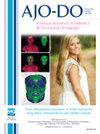The bone thickness of the midpalatal suture in adults with different sagittal facial patterns: An exploratory study using cone-beam computed tomography images
IF 3
2区 医学
Q1 DENTISTRY, ORAL SURGERY & MEDICINE
American Journal of Orthodontics and Dentofacial Orthopedics
Pub Date : 2025-05-31
DOI:10.1016/j.ajodo.2025.04.010
引用次数: 0
Abstract
Introduction
The objective of this study was to investigate the bone thickness of the midpalatal suture (BTMS) in adults with different sagittal facial patterns using cone-beam computed tomography (CBCT) images and explore potentially relevant factors that may affect BTMS.
Methods
CBCT images from 260 adult subjects with normodivergent facial patterns were divided into 3 groups (skeletal Class Ⅰ, Ⅱ, and Ⅲ). BTMS, maxillary base width, ANS-PNS length, and the angle between the palatal plane and the incisive foramen-PNS connection (PP-IP angle) were measured and analyzed from the pretreatment CBCT. The midpalatal suture was then trisected into H-front, H-middle, and H-end segments. Pearson’s correlation and regression analyses were applied to explore the correlation between the BTMS and other relevant factors.
Results
The BTMS in the Class Ⅰ, Ⅱ, and Ⅲ groups were 5.90 ± 1.28 mm, 5.70 ± 1.17 mm, and 5.50 ± 1.34 mm, respectively. The BTMS, H-middle, and H-end parts in the Class Ⅲ group were significantly thinner than those in the Class Ⅰ group (P <0.05). The maxillary base width and ANS-PNS length in the Class Ⅲ group were significantly smaller than those in the Class Ⅰ group. Within 3 groups, the BTMS, maxillary base width, and ANS-PNS length of males were greater than those of females. The BTMS was positively correlated with maxillary base width (r = 0.281; P <0.001), ANS-PNS length (r = 0.223; P <0.001), and PP-IP angle (r = 0.444; P <0.001).
Conclusions
Within the limitation of this study, adult patients with skeletal Class Ⅲ normodivergent malocclusion seem to have thinner midpalatal sutures, narrower maxillary base widths, and shorter ANS-PNS lengths than those patients with a skeletal Class Ⅰ relationship. Maxillary base width and PP-IP angle may have a positive correlation with BTMS.
不同矢状面型成人中腭缝合线的骨厚度:一项使用锥束计算机断层成像的探索性研究。
前言:本研究的目的是利用锥形束计算机断层扫描(CBCT)研究不同矢状面型成人的中腭缝合线(BTMS)骨厚度,并探讨可能影响BTMS的潜在相关因素。方法:260例正常面部特征的成人CBCT图像分为3组(骨骼组Ⅰ、Ⅱ、Ⅲ)。在预处理CBCT上测量BTMS、上颌基底宽度、ANS-PNS长度、腭平面与锐孔- pns连接之间的夹角(PP-IP角)并进行分析。然后将中腭缝线三切为h前段、h中段和h端段。应用Pearson相关分析和回归分析探讨BTMS与其他相关因素的相关性。结果:Ⅰ、Ⅱ、Ⅲ组BTMS分别为5.90±1.28 mm、5.70±1.17 mm、5.50±1.34 mm。Ⅲ类组的BTMS、H-middle、H-end部分明显比Ⅰ类组薄(P)。结论:在本研究的限制范围内,与Ⅰ类相关的成人骨骼类Ⅲ正矫直型错颌患者相比,其中腭缝合线更薄,上颌基宽度更窄,ANS-PNS长度更短。上颌基宽、PP-IP角与BTMS可能呈正相关。
本文章由计算机程序翻译,如有差异,请以英文原文为准。
求助全文
约1分钟内获得全文
求助全文
来源期刊
CiteScore
4.80
自引率
13.30%
发文量
432
审稿时长
66 days
期刊介绍:
Published for more than 100 years, the American Journal of Orthodontics and Dentofacial Orthopedics remains the leading orthodontic resource. It is the official publication of the American Association of Orthodontists, its constituent societies, the American Board of Orthodontics, and the College of Diplomates of the American Board of Orthodontics. Each month its readers have access to original peer-reviewed articles that examine all phases of orthodontic treatment. Illustrated throughout, the publication includes tables, color photographs, and statistical data. Coverage includes successful diagnostic procedures, imaging techniques, bracket and archwire materials, extraction and impaction concerns, orthognathic surgery, TMJ disorders, removable appliances, and adult therapy.

 求助内容:
求助内容: 应助结果提醒方式:
应助结果提醒方式:


